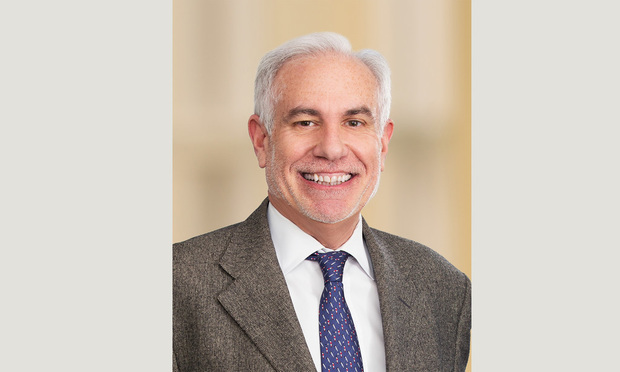Law in the Time of Coronavirus
Law and literature both grow out of the impulse to mythologize and ritualize, which is to say they share common roots, so there's no better time to explore that connection than in the midst of the current pandemic, writes Randy D. Gordon of Barnes & Thornburg.
April 06, 2020 at 07:55 PM
6 minute read
 Randy D. Gordon of Barnes & Thornburg. (Courtesy photo)
Randy D. Gordon of Barnes & Thornburg. (Courtesy photo)
The philosopher/cultural critic Rene Girard once remarked that "the plague is found everywhere in literature. … It is older than literature—much older, really, since it is present in myth and ritual in the entire world." Law and literature both grow out of the impulse to mythologize and ritualize, which is to say they share common roots, so I propose—as my title's nod to Gabriel García Márquez suggests—that there's no better time to explore that connection than in the midst of the current pandemic.
Bibliographies dedicated to "plague literature" run to dozens of pages, so we can only hope to discuss a small sample here. A convenient starting place is Giovanni Boccaccio's "The Decameron," the controlling conceit of which is that seven young women and three men have decamped for the countryside, where each will tell 10 stories (many bawdy) over 10 days, to escape the pestilent atmosphere of 14th century Florence.
"The Decameron" reveals a sharp divide between the humorous stories told in good fun and the horrors of the plague that serve as the occasion for them. The plague brings with it economic disaster, eroded social conventions, and political entropy. Literary scholar David Steel is thus right to argue, I think, that "there is a sense in which the age of modern fiction was ushered in by a virus."
Boccaccio's rough contemporary, Geoffrey Chaucer, began—in "The Canterbury Tales"—what became the standard literary practice of grimly reciting death statistics: "An unseen thief, called Death, came stalking by, / Who hereabouts makes all the people die … . / He's slain a thousand with this pestilence." By the time we get to Daniel Defoe's "A Journal of the Plague Year" (a 1720s fictional account of the 1665 London plague), "the backbone of the story," as Steel observes, "is not provided by dramatic incident or descriptions, but by numbers. … Defoe works into narrative the weekly bills of mortality kept by the parishes."
Mary Shelley's "The Last Man," which is the first (or at least one of the first) apocalyptic novels, develops the theme of human, political acts at the root of pandemics and—even more important—the whipsaw between denial and isolationism. At first, only far-away countries fall under the grip of an insulating "otherism": "We feared the coming summer. Nations, bordering on the already infected countries, began to enter upon serious plans for the better keeping out of the enemy. We, a commercial people, were obliged to bring such schemes under consideration; and the question of contagion became matter of earnest disquisition."
But a seemingly pragmatic business-as-usual mindset takes hold of the English mind, as Shelley observed: "There was no immediate necessity for an earnest caution. England was still secure. France, Germany, Italy and Spain, were interposed, walls yet without a breach, between us and the plague. Our vessels truly were the sport of winds and waves, even as Gulliver was the toy of the Brobdingnagians; but we on our stable abode could not be hurt in life or limb by these eruptions of nature." In short, we're predisposed to get it wrong.
When we reach the 20th century, Shelley's ultimate optimism (her protagonist sets out from the Italian coast to search for other survivors) gives way to existential dread. Jack London's "The Scarlet Plague," which anticipated the Spanish Flu epidemic by a few years, blamed capitalism and its attendant overcrowded urbanism for the earth's devastation.
Albert Camus' "The Plague," which is sometimes read as an allegory of the Nazi occupation of France, demonstrates that pestilence, like all human suffering, is always with us: "The plague bacillus never dies or disappears for good; that it can lie dormant for years and years in furniture and linen-chests; that it bides its time in bedrooms, cellars, trunks, and bookshelves; and that perhaps the day would come when, for the bane and enlightening of men, it would rouse up its rats again and send them forth to die in a happy city." This is to say, as Steel puts it, that the plague's "ultimate pertinence as a literary symbol is not that men die from the plague but that man is plagued by death."
If there's a thread that runs through the "plague" literary genre, it's the notion that pandemics upend the social and moral order of civilian life—including the law. Girard quotes the French surgeon Ambroise Paré for that particular point: "At the outbreak of the plague, even the highest authorities are likely to flee, so the administration of justice is rendered impossible and no one can obtain his rights. General anarchy and confusion then set in and that is the worst evil by which the common wealth can be assailed."
That plague—the metaphoric reign of chaos—has not been visited on us: our courts are functioning and most of us are going about our law-jobs in more-or-less orderly fashion. But we're starting to hear loud complaints about businesses being closed, infringement of free-travel rights, utilitarian rationing of healthcare, and then there are the omnipresent shelter-in-place mandates, which are just a step away from general quarantine orders. Although Defoe saw benefit in the Lord Mayor's quarantine dictates, he worried that they didn't "answer the end at all, serving more to make the people desperate, and drive them to such extremities as that they would break out at all adventures."
One of the most problematic—yet necessary—aspects of pandemic management is the isolation of the infected. I grew up in western Kansas in a small town that hosted—four miles to the east—a state tuberculosis sanitarium. Although family lore has it that my great-grandfather had worked there as a custodian of some sort, we never went near it for fear of infection. And the irony is not lost on me that—after TB was mostly eradicated—the facility was easily repurposed as a prison!
So, with Jack London, I worry most about the consequences of seclusion: "It was amazing, astounding, this loss of communication with the world. It was exactly as if the world had ceased, been blotted out."
Randy D. Gordon is a partner at Barnes & Thornburg and co-chairs the antitrust practice group. He is executive professor of law and history at Texas A&M University.
This article should not be construed as legal advice or legal opinion on any specific facts or circumstances. The contents are intended for general informational purposes only, and you are urged to consult your own lawyer on any specific legal questions you may have concerning your situation.
This content has been archived. It is available through our partners, LexisNexis® and Bloomberg Law.
To view this content, please continue to their sites.
Not a Lexis Subscriber?
Subscribe Now
Not a Bloomberg Law Subscriber?
Subscribe Now
NOT FOR REPRINT
© 2025 ALM Global, LLC, All Rights Reserved. Request academic re-use from www.copyright.com. All other uses, submit a request to [email protected]. For more information visit Asset & Logo Licensing.
You Might Like
View All
Blake Lively Is Sued by Texas Crisis Specialist in Latest 'It Ends With Us' Lawsuit
4 minute read


Law Firms Mentioned
Trending Stories
- 1ACC CLO Survey Waves Warning Flags for Boards
- 2States Accuse Trump of Thwarting Court's Funding Restoration Order
- 3Microsoft Becomes Latest Tech Company to Face Claims of Stealing Marketing Commissions From Influencers
- 4Coral Gables Attorney Busted for Stalking Lawyer
- 5Trump's DOJ Delays Releasing Jan. 6 FBI Agents List Under Consent Order
Who Got The Work
J. Brugh Lower of Gibbons has entered an appearance for industrial equipment supplier Devco Corporation in a pending trademark infringement lawsuit. The suit, accusing the defendant of selling knock-off Graco products, was filed Dec. 18 in New Jersey District Court by Rivkin Radler on behalf of Graco Inc. and Graco Minnesota. The case, assigned to U.S. District Judge Zahid N. Quraishi, is 3:24-cv-11294, Graco Inc. et al v. Devco Corporation.
Who Got The Work
Rebecca Maller-Stein and Kent A. Yalowitz of Arnold & Porter Kaye Scholer have entered their appearances for Hanaco Venture Capital and its executives, Lior Prosor and David Frankel, in a pending securities lawsuit. The action, filed on Dec. 24 in New York Southern District Court by Zell, Aron & Co. on behalf of Goldeneye Advisors, accuses the defendants of negligently and fraudulently managing the plaintiff's $1 million investment. The case, assigned to U.S. District Judge Vernon S. Broderick, is 1:24-cv-09918, Goldeneye Advisors, LLC v. Hanaco Venture Capital, Ltd. et al.
Who Got The Work
Attorneys from A&O Shearman has stepped in as defense counsel for Toronto-Dominion Bank and other defendants in a pending securities class action. The suit, filed Dec. 11 in New York Southern District Court by Bleichmar Fonti & Auld, accuses the defendants of concealing the bank's 'pervasive' deficiencies in regards to its compliance with the Bank Secrecy Act and the quality of its anti-money laundering controls. The case, assigned to U.S. District Judge Arun Subramanian, is 1:24-cv-09445, Gonzalez v. The Toronto-Dominion Bank et al.
Who Got The Work
Crown Castle International, a Pennsylvania company providing shared communications infrastructure, has turned to Luke D. Wolf of Gordon Rees Scully Mansukhani to fend off a pending breach-of-contract lawsuit. The court action, filed Nov. 25 in Michigan Eastern District Court by Hooper Hathaway PC on behalf of The Town Residences LLC, accuses Crown Castle of failing to transfer approximately $30,000 in utility payments from T-Mobile in breach of a roof-top lease and assignment agreement. The case, assigned to U.S. District Judge Susan K. Declercq, is 2:24-cv-13131, The Town Residences LLC v. T-Mobile US, Inc. et al.
Who Got The Work
Wilfred P. Coronato and Daniel M. Schwartz of McCarter & English have stepped in as defense counsel to Electrolux Home Products Inc. in a pending product liability lawsuit. The court action, filed Nov. 26 in New York Eastern District Court by Poulos Lopiccolo PC and Nagel Rice LLP on behalf of David Stern, alleges that the defendant's refrigerators’ drawers and shelving repeatedly break and fall apart within months after purchase. The case, assigned to U.S. District Judge Joan M. Azrack, is 2:24-cv-08204, Stern v. Electrolux Home Products, Inc.
Featured Firms
Law Offices of Gary Martin Hays & Associates, P.C.
(470) 294-1674
Law Offices of Mark E. Salomone
(857) 444-6468
Smith & Hassler
(713) 739-1250






